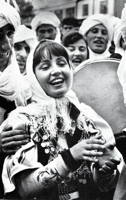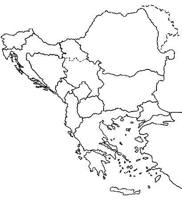
|
The Society of Folk Dance Historians (SFDH)
The Intellectual Fascination of the Balkans
[
Home |
About |
Encyclopedia | CLICK AN IMAGE TO ENLARGE |

|
 There are two kinds of pleasant intellectual experience: the sudden revelation that brings forth a flash of satisfaction, like understanding a problem in mathematics, and the lasting, cyclical combination of curiosity and inquiry that continually reveals new facets of the same cluster of questions. The latter is what happens, I think, to many of those who have thought about, or who have been personally exposed to, the Balkans. Thus, even if each person who thinks about the Balkans has his unique, correct or incorrect, view of it, his concern with this part of Europe is more like a reflective, cyclical fascination than a disciplined, rational concern.
There are two kinds of pleasant intellectual experience: the sudden revelation that brings forth a flash of satisfaction, like understanding a problem in mathematics, and the lasting, cyclical combination of curiosity and inquiry that continually reveals new facets of the same cluster of questions. The latter is what happens, I think, to many of those who have thought about, or who have been personally exposed to, the Balkans. Thus, even if each person who thinks about the Balkans has his unique, correct or incorrect, view of it, his concern with this part of Europe is more like a reflective, cyclical fascination than a disciplined, rational concern.
If this is so, why is it so? Other areas generate fascination; Ireland and India can serve as examples. Is a fascination with the Balkans different or unique? If so, why?
There are a few places in the world that, as a result of the combination of their topography and history, are intrinsically more complicated than others: certain parts of West Africa and of Central America, the Caucasus, the Indo-Chinese peninsula, and the Balkans. In all of these, the fact that the mountains on the one hand and the valleys on the other have for centuries housed parallel but different courses of economic, cultural, and political history that plays a major role. The more integrated such an area becomes in a modern, gigantic, industrial-economic system, the more likely it is that its older, inherited features will erode. Still, some will survive.
Fascination No. 1, in one's fascination, is the ability to discover archaic survivals in such a cultural area. If the area is ethnographically complex, as the Balkans are, any little discovery will unveil a further network of problems and hence further opportunities for fascination.
Fascination No. 2 lies in the very complicatedness of the Balkans. The Serbians, Montenegrins, Macedonians, and Bulgarians may all look like Slavs – whatever that means – to the unpracticed eye, but a little exposure to any two of these groups will reveal differences between them that deserve a lifetime of reflection. Such a concern becomes compounded if we think of groups that lie at or beyond the periphery of the Balkans, such as the Croatians or the Slovenes. And yet how strangely homogenous – by the side of this variety – is the world of the Slavs (including Czechs, Russians, and all others) when we view them all together as a family, against a European backdrop. Or, let us think of the Romanians: a large mass of Daco-Romanians (occupying more or less present-day Romania) and the tiny islands of Aromanians and Megleno-Romanians south of the Danube River and the tinier island of Istro-Romanians in Istria (between westernmost Yugoslavia and Northeast Italy). Such wandering Romanians must have penetrated into present-day central Czechoslovakia; an area there is still called Malá Vlaša ("Little Walachia") to this day. Any inquisitive mind will be staggered by this strange constellation, even with a minimum of ethnographical and historical information. And who are the Albanians, this linguistically isolated group who, in the last alalysis, are the surviving example of earlier models of existence in the Balkans? The force that propelled the sheep-herding Romanians to Malá Vlaša was the Albanian type of pastoralism which, we must assume, was a characteristic mode of life in the Balkans at one time. Finally, Greece, the fulcrum of the Balkans, ties them in time to Byzantium, to Hellas, and to the remotest antiquity, and in space to Asia Minor, Italy, and the rest of the world.
The religious picture, Fascination No. 3, is equally forceful in inducing breathless, creative curiosity. Balkan orthodoxy emanates from the Greeks; it is historically an analogue of Roman Catholicism and hence in a kin-relationship with all other Christian churches in Europe, Africa, and the Near East. Its liturgy has a familiar and yet an uncanny – perhaps atavistic? – ring. this Orthodox area, that extends from Serbia to Russia, but whose historical core is in the Balkans (perhaps Saloniki) is spiced by striking enclaves of Islam. These Muslim folk are represented not only by the few Turks who remain in the Balkans but also by some Slavs and some Albanians. Who can resist speculating on this strange mesh of ethnic and ideological strains? Finally, the two religious minorities, the Armenians and the Sephardic Jews, evoke entirely different avenues of fascination and immediately transport us to those earlier bridges that connected the Balkans with the East and with the West.
The political history of the Balkans (Fascination No. 4) is not less arresting than the few cultural morsels pointed out above. The climate in the Balkans keeps changing dramatically: Roman legions, Slavic and Proto-Bulgarian invasions, the Bulgarian Empire, the Albanian heroes, the Turks. These Turks, who juggled Austria and Russia against each other for centuries were not as monolithic as the history-ponies would lead us to believe: they consisted, first of all, of at least two (Seljuk and Ottoman) layers; they had absorbed large dosages of Persian culture and were immersed in Arabic Islam; they employed Balkan nobles and ignobles from all ethnic groups as well as Italians and Poles; and they had advanced notions of administration, diplomacy, and of the art of war. And, who defined the northwestern boundary of the Balkans? The Hungarians, when they were defeated by the Turks at Mohács in 1525. (Louis V of Lorraine defeated the Turks there in 1687.)
Not even present political fibre of the Balkans is without its fascination (Fascination No. 5): a spectrum of three socialist countries, each with its distinctive color, Albania–Bulgaria–Romania; Yugoslavia, a vigorous federation of the most diverse partners; and Greece, a kingdom without its (German-Danish) royal family.
DOCUMENT
- Balkans, a region.
Used with permission of the
Center for Traditional Music and Dance Archive, www.ctmd.org.
Printed in Spring Folk Festival 1973.
This page © 2018 by Ron Houston.
Please do not copy any part of this page without including this copyright notice.
Please do not copy small portions out of context.
Please do not copy large portions without permission from Ron Houston.